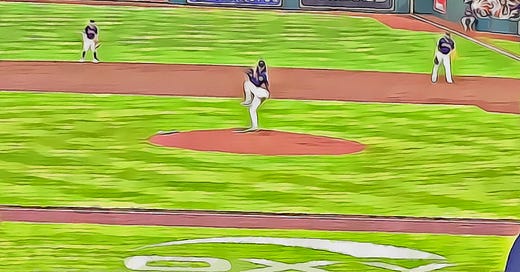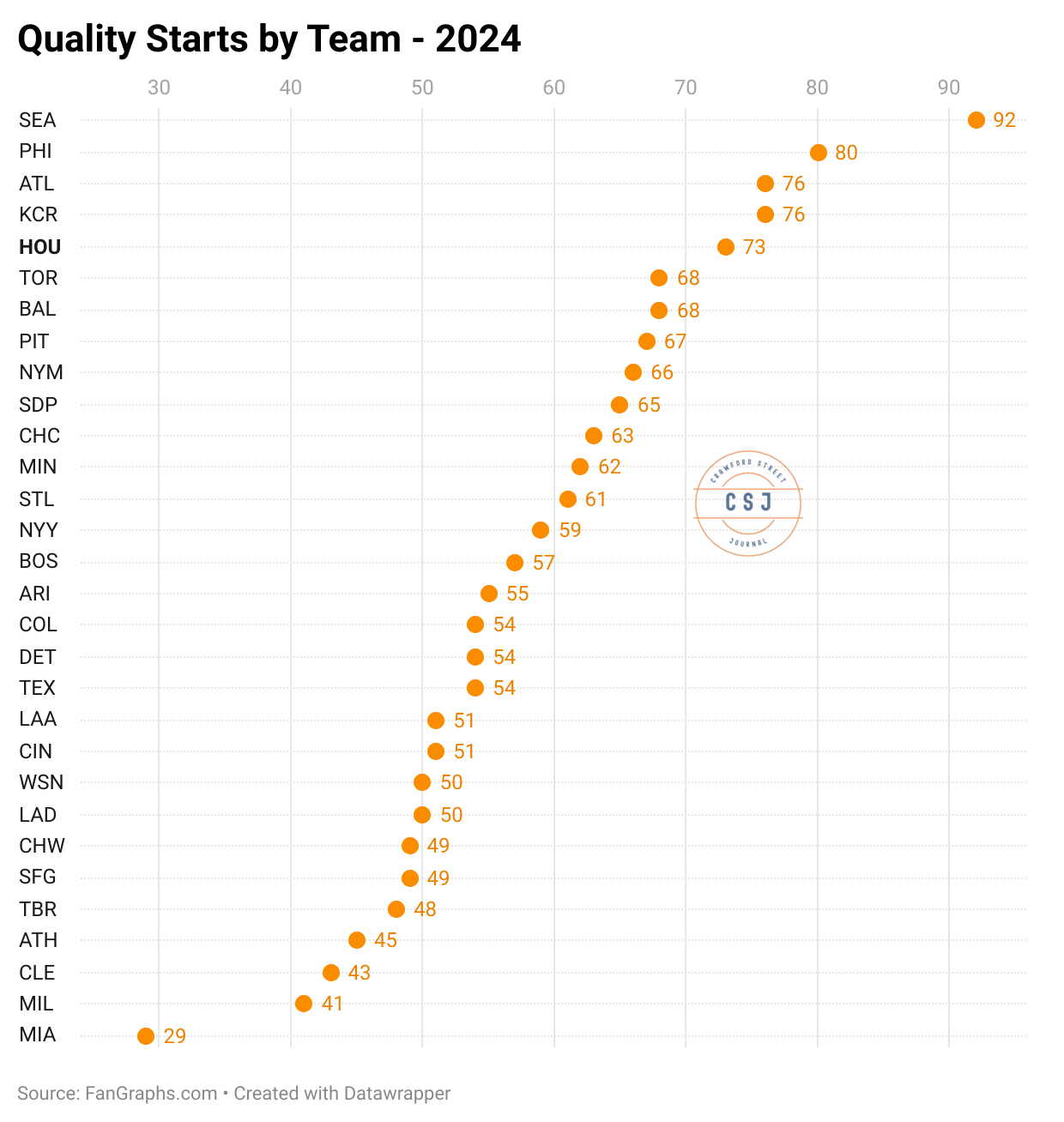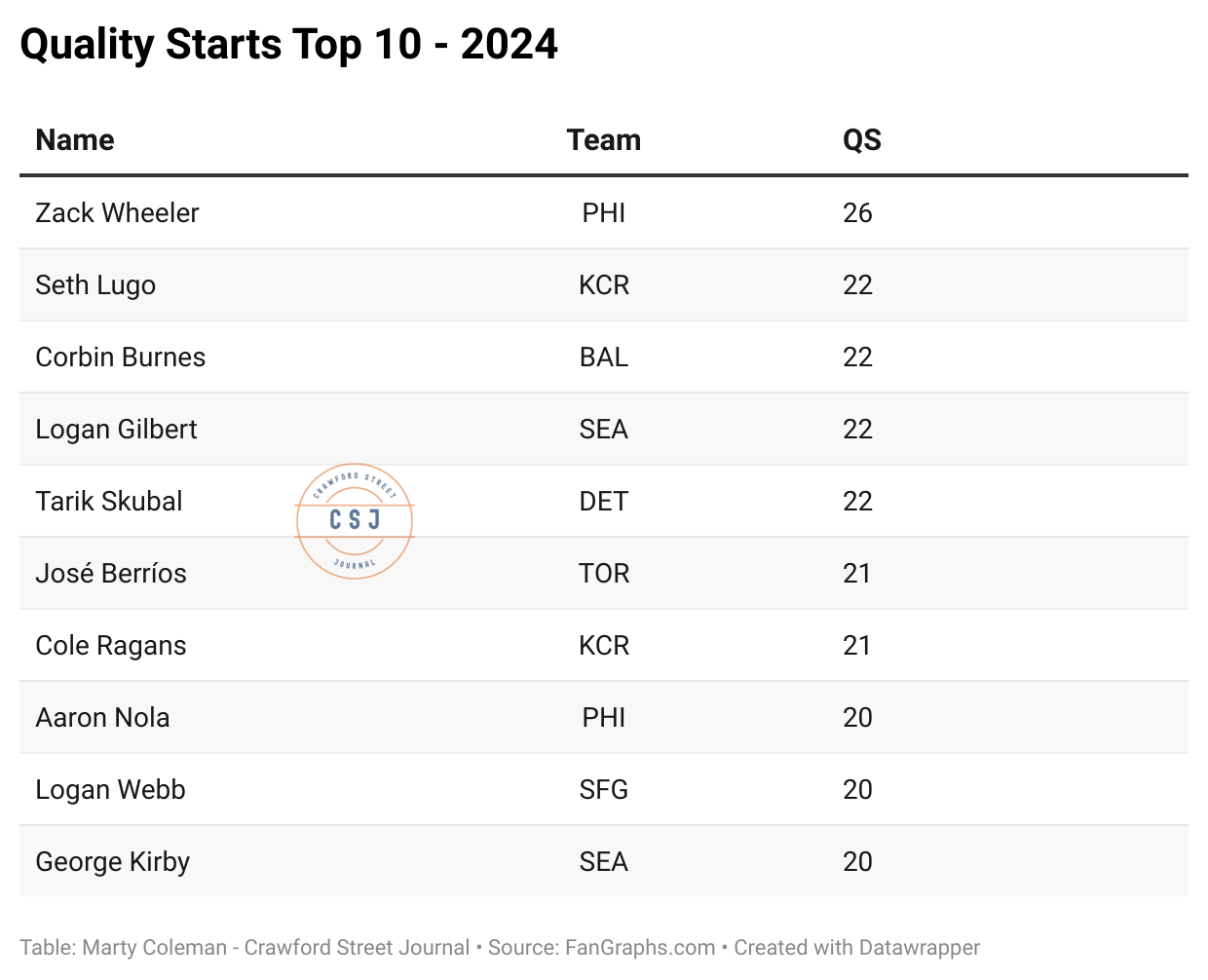A Deep Dive into Quality Starts
Oft-derided, the old school metric can actually tell us a lot
With the rise of fantasy baseball, the quality start has gotten a bad rap as a made-up stat that means little to nothing even though only 36% of starts resulted in a quality start in 2024, telling us that it isn’t as easy to accomplish in modern baseball as some may think.
The typical response is, “A quality start is six innings and three earned runs, that’s a 4.50 ERA and that’s not very good.”
That may be true in the fantasy world where points are accumulated for counting stats like wins, strikeouts, walks and saves, but it’s far from the truth in the real baseball world where a quality start drastically improves a team’s chances of winning, whether or not the starter racks up fantasy points.
In 2024, teams that get a quality start won 69% of the time; if a team gets a quality start and the opposing team doesn’t, it’s closer to 77%.
A simple example of the effect of quality starts: Even the 63-99 Los Angeles Angels of Anaheim won 61% of their quality starts last season and 29 of 30 teams had winning records when getting a quality start.
The average 2024 quality start lasted about 6.5 innings, resulting in 1.2 earned runs, for a 1.70 ERA, 5.9 hits per 9 IP, 8.4 K per 9 IP and just 1.9 BB per 9 IP.
That “6 inning, 3 earned runs” argument ignores that those are the minimum and only accounted for less than 9% of quality starts last season.
It’s similar to proclaiming because left field at Daikin Park is 315 feet, the 450-foot bomb you hit onto the train track is a cheap home run.
In short, it’s wrong.
The average 2024 quality start lasted about 6.5 innings, resulting in 1.2 earned runs, for a 1.70 ERA, 5.9 hits, 8.4 K and just 1.9 BB per 9 IP.
Outside those numbers, there are several non-statistical benefits to quality starts like less bullpen usage, a faster pace and the fact that your team is almost always has a chance to win the game, or at the very least is “in the game”.
While quality starts are a factor, they’re certainly not the perfect answer to who is likely to win a game.
For example, the Seattle Mariners had 12 more quality starts than any team last season with 92, but failed to make the playoffs.
Quality starts weren’t the reason the Mariners didn’t make the playoffs: The Mariners went 61-31 (66.3%) when getting a quality start and just 24-46 (34.3%) when not.
The potential for a quality start is generally built into the odds set for a game, especially for pitchers like Zack Wheeler or Tarik Skubal.
But what about pitchers like Tanner Houck?
Houck finished last season 9-10 and the Red Sox were only 16-14 in his starts, but when he threw a quality start the team was 12-7.
Betting on the Red Sox when Houck pitched was a crapshoot that was right 53.3% of the time, likely a losing bet when the Vig is figured in.
But, what if we could improve our odds by identifying times Houck is more likely to throw a quality start using readily available data to find an edge?
We know exactly what teams Houck threw quality starts against, when and where they happened and the results.
For example, two of Houck’s 19 quality starts were against the Athletics, one in Boston and one in Oakland, the only two times he faced the A’s last season.
In those two games combined Houck pitched 12 innings, gave up 5 hits, 0 runs, struck out 16 and walked 3.
You don’t randomly bet on Tanner Houck because he threw 19 quality starts. You use data to narrow down when those quality starts are more likely to happen.
There’s other factors to consider, of course, but this is a good start.
We can also narrow down when quality starts are more likely to happen across the league. There’s a pattern to quality starts of fewer early and later in the season, with the number peaking in May and June as arms are stretched out, relatively fresh and there’s been less time for injuries to accumulate.
By July, as injuries mount and arms fatigue, the odds of getting a quality start decrease to average and then underwater for the season's last two months.
For the coming season, I plan to track quality starts throughout the season and identify games where there may be an advantage based on the data.
Over the coming weeks, I’ll be working to hone my approach using data from previous seasons and be ready for Opening Day.
I’m a believer in using data to become a more informed bettor, especially in baseball where the data is abundant and readily available.
I invite you to join me and follow along throughout the season as I put this great hypothesis to the test.
As always, thanks for reading!








